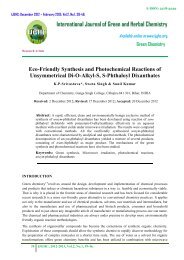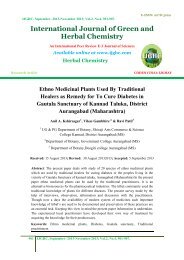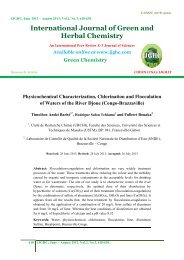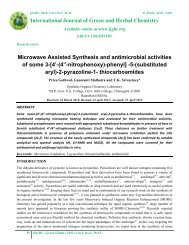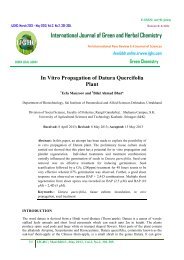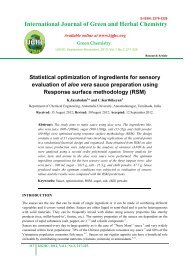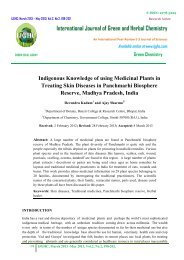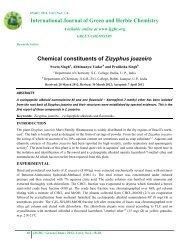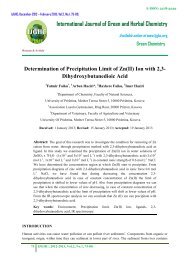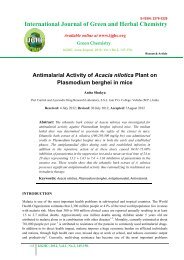(VI) From Aqueous Solution by Using Low Cost Material - IJGHC
(VI) From Aqueous Solution by Using Low Cost Material - IJGHC
(VI) From Aqueous Solution by Using Low Cost Material - IJGHC
You also want an ePaper? Increase the reach of your titles
YUMPU automatically turns print PDFs into web optimized ePapers that Google loves.
E-ISSN: 2278-3229International Journal of Green and Herbal ChemistryAvailable online at www.ijghc.orgGreen Chemistry<strong>IJGHC</strong>; June-August, 2012; Vol.1.No.2, 169-175.Research ArticleRemoval of Cr (<strong>VI</strong>) <strong>From</strong> <strong>Aqueous</strong> <strong>Solution</strong> <strong>by</strong> <strong>Using</strong><strong>Low</strong> <strong>Cost</strong> <strong>Material</strong> (Jambhool Leaf Powder)Suresh Kumar Halnor¹, Mazahar Farooqui², Abdo Taher² and Milind Ubale*³¹Department of Chemistry, Padmashri Doctor Vithalrao Vikhe Patil College ofEngineering Ahmednagar (M.S.) India²Post Graduate and Research Centre Maulana Azad College Aurangabad (M.S.) India³Post Graduate Department of Chemistry Vasantrao Naik Mahavidyalaya Aurangabad(M.S.) IndiaReceived: 14July 2012; Revised: 7August 2012; Accepted: 16 August 2012Abstract: Jambhool (Syzygium Cumini) Leaf Powder (JLP) was treated withnitric acid and used as a low cost, easily available and renewable biologicaladsorbent for the removal of chromium ions from aqueous solution. Batchexperiments were carried out for adsorption kinetics and isotherms. Operatingvariable studied were contact time, adsorbent dose, initial concentration ofadsorbate, temperature and pH Adsorption capacity seems to be enhanced <strong>by</strong>increasing temperature, adsorbent dose. Maximum adsorption was found to be atpH 2. Equilibrium data were well represented <strong>by</strong> the Freundlich isotherm model forall tested adsorption systems. Beside these the Thermodynamic study has showedthat the Cr (<strong>VI</strong>) adsorption phenomenon onto JLP was favourable for endothermicand was spontaneous.Keywords: <strong>Low</strong> cost material, Cr (<strong>VI</strong>), adsorption.INTRODUCTIONAn increase in population increased the industrialization and increase the discharge of effluents intowater bodies, this discharge contain heavy metals like Chromium, Zinc, Copper, Nickel, Iron ,Lead etc.Chromium exist in two oxidation states Cr (III) and Cr (<strong>VI</strong>). Cr (<strong>VI</strong>) is discharged into environmentthrough glass, canning, paint, ceramics, electroplating and tanning industries 5-7.169 <strong>IJGHC</strong>; 2012, Vol.1, No.2, 169-175.
Antioxidant...Sureshkumar Halnor et al.Cr (<strong>VI</strong>) is very toxic in nature and exposure to Cr (<strong>VI</strong>) affects human beings, animals and plants.Occupational exposure to Cr (<strong>VI</strong>) has been associated with increased incidence of lung cancers¹. Toxicmetals can be removed <strong>by</strong> ion exchange, precipitation, reverse osmosis, evaporation, and electrodialysisetc³. These methods were found unaffordable in India for removal of Cr due to operational difficulties andhigh treatment expenditure. Activated carbon is the most widely used adsorbent but commerciallyavailable activated carbons are very expensive⁴.Adsorption using low cost adsorbents is one of the effective and economic method³. Various low costadsorbents have been used for the removal of heavy metals e.g. brick kiln ash, fly ash, bidi leaves, teakleaves, amla dust , wollastonite, peanut hull and neem leaves³. Literature survey reveals that the use ofJLP as a low cost adsorbent for removal of heavy metals from aqueous solutions has not been reportedThus in the present study the systematic work was carried to investigate the adsorption properties of JLPfor the removal of Cr (<strong>VI</strong>) .The study includes adsorption as a function of time, adsorbent dose,concentration of Cr (<strong>VI</strong>) solution, temperature and pH of solution, Isotherm studies were fitted forFreundlich and Langmuir adsorption isotherm.MATERIALS AND METHODSPreparation of adsorbent: The adsorbent selected for the present study was Jambhool which is locallyavailable medicinal plant and was collected in Ahmednagar District of Maharashtra. The sample leaveswere dried in shadow, avoiding direct sunlight on them. The dried plant material of Jambhool was grindedinto powder and washed with distilled water and filtered. The residue left was treated with very dilutesolution of nitric acid (0.1 N). It was then stirred for half an hour vigorously using mechanical stirrer atroom temperature. Then it was filtered and washed with distilled water repeatedly to remove free acid.After chemical treatment the residue was dried first in air and finally in oven at 90-100 0 C for 8-10 hoursand powdered using electric grinder. The homogeneous powder was passed through mesh for desiredparticle size. The adsorbent once prepared was used throughout the experimental work. The particle sizeof adsorbent selected for these experiments was on the basis of their settlement at the bottom of thesystem, so that the portion of the solution could be taken out conveniently from the supernant liquid.Preparation of Cr (<strong>VI</strong>) metal ion solution: Chromium was the metal ion selected for the presentinvestigation. Cr (<strong>VI</strong>) prepared <strong>by</strong> dissolving potassium dichromate in double distilled water. Thechemicals used were of analytical grade and used without further purifications. The solutions wereprepared in doubly distilled water. A distilled water prepared <strong>by</strong> using first metal distillation unit and thenall quick fit glass assembly in permanganatic condition, wherever necessary the prepared solutions werestandardized as per literature.Adsorption experiments: Each batch adsorption study was carried out <strong>by</strong> using nitric acid treated JLPwith Chromium ion solution under different conditions at maximum time 60 minutes. Chromium wasdetermined using spectrophotometer (SL-159 ELICO UV-<strong>VI</strong>SIBLE SPECTROPHOTOMETER) at λ max540 nm.RESULTS AND DISCUSSIONThe experimental data obtained from the different batch type experiments, in the presentinvestigation was analyzed and interpreted based on the adsorption of Cr (<strong>VI</strong>) on JLP.Effect of contact time: In the present findings adsorption of Chromium ion onto the surface ofJLP increases with time up to 60 minutes which is in good agreement with the reported work of170 <strong>IJGHC</strong>; 2012, Vol.1, No.2, 169-175.
Removal...Sureshkumar Halnor et al.Rao et.al.⁹.The affinity of metal ion towards the surface of JLP beyond 60 minutes decreaseswhich may be attributed to the accumulation of cracks, corners, peaks present on the surface ofJLP <strong>by</strong> metal ions, thus contact time of 60 minutes was kept as a equilibrium contact time for allsets of experimental work, which is in good support of the reported work <strong>by</strong> Tangjuank et.al 1.Fig.1: Effect of contact time on removal of Cr (<strong>VI</strong>)Effect of adsorbent dose: Effect of adsorbent dose plays an important role in standardizing theadsorption process with quantification of adsorbate solution and the adsorbent. In our presentinvestigation with increase in the amount of JLP adsorbent the removal efficiency increased rapidly(Fig.2) which may be attributed to the greater availability of the exchangeable sites or surface areas athigher concentration of the adsorbent. Our findings are in good support with Hussein.et.al. 11-12 .Fig.2: Effect of adsorbent dose on removal of Cr (<strong>VI</strong>)171 <strong>IJGHC</strong>; 2012, Vol.1, No.2, 169-175.
Antioxidant...Sureshkumar Halnor et al.Effect of initial concentration of adsorbate: The adsorption of Chromium onto the surface of JLP wasrapid initially, slows down later on and finally reached towards equilibrium indicating saturatedadsorption¹³. The increased in adsorption may be attributed to increase in surface activity and due tomicelle formation or the aggregation of chromium ions in the concentration range studied¹³. Thepercentage removal of Chromium has shown significant decrease with the increase in the initialconcentration of adsorbate (Fig.3). Our findings are in good agreement with the reported work of soyabean hull as adsorbent <strong>by</strong> Jambulingam et.al.⁸.Fig.3: Effect of initial concentration of adsorbate on removal of Cr (<strong>VI</strong>)Effect of temperature: In the present investigation effect of temperature on adsorption of Chromium ionon to the JLP surface was carried at different temperature range (293-333 K), while the other parameterswere kept constant. Adsorption increases with increase in temperature implies that the process isendothermic adsorption. (Fig.4), which may be attributed to the increase in number of adsorption sitescreated on the surface of JLP as a result of cleavage of some internal bond, which is in good agreementwith Berket et.al 16Fig.4: Effect of temperature on removal of Cr (<strong>VI</strong>)172 <strong>IJGHC</strong>; 2012, Vol.1, No.2, 169-175.
Removal...Sureshkumar Halnor et al.Effect of pH: Adsorption as the effect of pH was carried out in different pH and found that adsorptionwas maximum at pH 2 (Fig.5). This showed that almost acidic pH was preferred for chromium removalusing adsorption technique using the adsorbent JLP and supported evidences to the investigation⁸.The initial pH value of the solution can significantly influence the adsorption. The adsorption at lower pHmay be attributed to the increase in the concentration of hydrogen ion in the solution which neutralizeshydroxyl group in the vicinity of adsorbent surface and facilitates the diffusion of chromium ions towardsthe surface of adsorbent. At higher pH may be due to the availability of large number of OH - (hydroxylions) and consequently the diffusion barrier is increased which results in poor adsorption 14 . At higher pHthere is a change in order of reaction with change in pH which suggests the role of adsorbent as it may bereaching out at higher pH as the adsorbent is plant material and consists of mainly various organic acidcomponents. This may lead to the formation of aqua complexes there<strong>by</strong> retarding the chromium ionadsorption 15 .Fig.5: Effect of pH on removal of Cr (<strong>VI</strong>)Adsorption Isotherm: The adsorption isotherm is a graphical representation of amount of substanceadsorbed against the residual concentration of the adsorbate concentration and adsorbent doses wereanalyzed using Langmuir and Freundlich isotherm in order to find the adsorption capacity of JLP.The Freundlich isotherm was verified, the value of regression coefficient r 2 found to be very close to onewhich indicates the good correlation exists between log x/m and log C. The Langmuir model representsmonolayer adsorption on a set of distinct localized adsorption sites having the same adsorption energiesno interaction between adsorbed molecules. The essential characteristic of Langmuir isotherm isexpressed (Table-1) in terms of dimensionless constant separation factor or equilibrium factor R L , whichis indicative of the nature of the isotherm and is enlisted below as:173 <strong>IJGHC</strong>; 2012, Vol.1, No.2, 169-175.
Antioxidant...Sureshkumar Halnor et al.Table-1: The essential characteristic of Langmuir isothermR L ValueR L >1R L = 1O < R L
Removal...Sureshkumar Halnor et al.6. Volesky B.;Sorption and Bisorption Montreal, St.Lambert, Quebec, Canada BV SorbexInc.;2003,316.7. K.J.Shiny, K.N. Remani,,T.K. Jalaja.and V.K. Sasidharan;Indian, J. Environ. Health;2004, 46,249.8.M.Jambulingam,N.Rehugadevi,S.Karthikeyan,J.Kiruthika,S.Pathabhi;IndianJ.Environ.Protect;2005,25(5),458.9. M.Rao and A.G. Bhole; J.Indian Water Works Assoc; 2001, 97,997.10. N.Balkaya, T.Bektas; Desalination and water treatment; 2009,3,43.11.M.Hussein,A.A.Amer Azza;J.of Appl.Sci.Res.;2007,3(11),1352.12.S.P.Raghuvanshi,R.Singh,C.P.Kaushik;Appl.Ecology & Env.Res;2004,2(2),35.13.R.S.Shelke,J.V.Bharad,B.R.Madje,M.B.Ubale;Archieves of Applied ScienceResearch;2010,2(3),260.14.P.Bahadur,M.Desai,A.Dogra,S.Vora;Indian J. Chemistry; 1997, 36(A), 938.15.S.V.Mohan,N.C.Rao,J.Karthikeyan;J.Hazard Mater.;2002,B(90),189.16.G.Bercket,A.Z.Arog,M.Z.Ozel; J. Colloid Interface Sci;1997,187,338.Correspondence Author: Milind Ubale; Post Graduate Department of ChemistryVasantrao Naik Mahavidyalaya Aurangabad, (M.S.) India175 <strong>IJGHC</strong>; 2012, Vol.1, No.2, 169-175.



